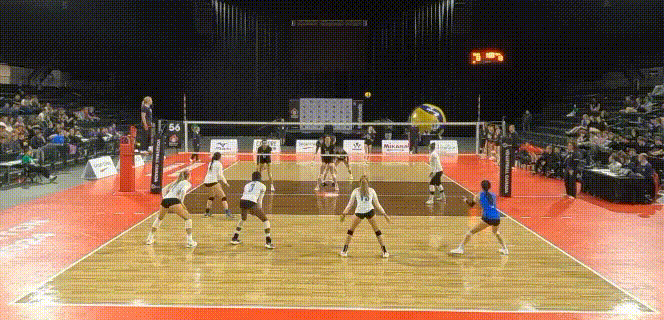My apologies for the delay in content; I’ve been on the road a ton these last two weeks, running camps and clinics at various programs. Here’s 10 thoughts:
(1) Recycling is a hot topic right now. I see both sides of it; some coaches are moderately puzzled and borderline offended that I want to teach it at all, or some want to do it, at the cost of getting good swings in transition. I’ll have more data coming out soon, but the recycling topic really makes me think about what Marv always stressed: coach in reality. I think a lot of recycling debate (on both sides) involves what might happen or what should happen instead of what does happen.
(2) I’m always surprised at how borderline controversial setting 1m inside is. Again, if you watch top teams, you see tons of sets contacted 3-5’ inside the antenna. I’m open to the debate that you might want to aim farther out, etc. But I think some coaches don’t realize how many balls are already contacted 3’ inside.
(3) Leading with those 2 statements sounds like I’m getting more pushback at these clinics than I really am. I’m actually constantly impressed by how many teams are willing to try some brand new stuff for a guest coach parachuting into their gym. Some of these teams I worked with this summer made significant changes in just 1 day.
(4) Two programs, in particular, got really fired up on scrape tipping. I think if you spend just a little time on this you will get 1 extra kill per match this high school season. I know those teams will.
(5) The most broadly popular part of my Offensive Concepts seminars has been the hour I spend teaching Nick Del Bianco-inspired rotation mechanics. Again, big gains here can come from a little application of this stuff every day.
(6) Aside from that, Jamball is always a popular one. I will get some video and make a Jamball post soon, I promise! 2v2 short-court + narrow-court. So simple but it’s the best way to get creative and powerful plays at the net happening with almost any team.
(7) In addition to Jamball, Lemonade has been both popular and helpful for a lot of teams. It’s a 6v6 transition game. It’s a lot like a GMS-style Ball-Setter-Ball-Hitter drill but it’s for the transition offensive team, rather than the defensive team. So I stand on Team A’s side for one player. Another coach or player snaps in a transition ball from the other side and I take the first touch. Sometimes I dig it under control, but sometimes I dig a “lemon” and the other team has to make… Lemonade… out of it. It’s really helpful in reducing hesitation and getting non-setters faster at stepping in and taking the ball.
(8) There’s a statement in volleyball circles that goes like, “don’t attempt tactically what you can’t do technically.” It’s a good one. However, I don’t think enough coaches take that statement and then think about what they want to do tactically and start training the technical components of it. This is what Organization-Mechanics-Skill is all about. Think about the system you want to get players into and what mechanics need to support that system. Then train those mechanics over time.
(9) Going along with the previous point, making a plan for what you can realistically add to your team’s system over the course of the season is one of the most important decisions that a coach can make. That’s one of the big parts of this Offensive Concepts seminar. I say something like, “if we cover 10 things today, 2 or 3 of them will be an instant simple upgrade, 2 or 3 of them you’ll just feel aren’t for you or aren’t going to click this year, and then there’s 3 or 4 more things in the middle that maybe you’re getting a feel for and will require some work to develop and add that piece to your offense over the season.” Choosing which of those 3 or 4 things (and in what order) you’ll focus on as a team is important. Aim for something too difficult tactically and you’ll never get it and you’ll waste a bunch of time. But if you don’t plan to add anything to your team’s system over the course of the season, then you might be limiting their growth.
(10) Even briefly talking with setters about what choices they’ll make and why goes a long way. Most high school setters just kind of… set the ball. But even doing simple exercises where you’re in-system and after the sideout play you say, “okay, why did you make that set,” are revealing. The most common answer is, “uhh…” Which like, is funny, when you tell coaches that at a clinic. But really, you can’t blame the kids this. They haven’t been taught. Most setters at 13 or 14 years old are just hoping to get to the ball and set something hittable. But at 16, 17, etc, they need to be able to verbalize why they made a choice, even if it was something as simple as, “umm… because she’s my best hitter?”
I still have a couple more events on the calendar for these last summer weekends, but if you want to get on the calendar for the winter, reach out to me now… I have fewer winter dates available and they will fill up faster.




